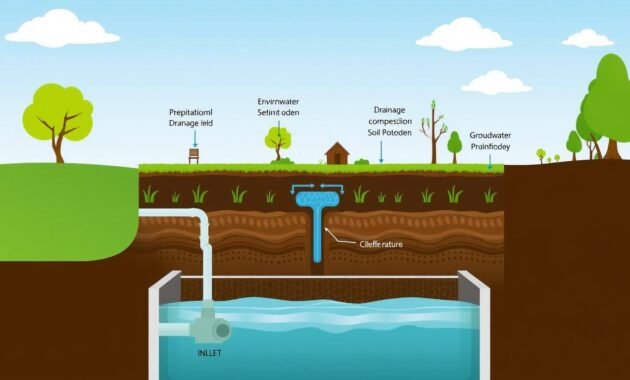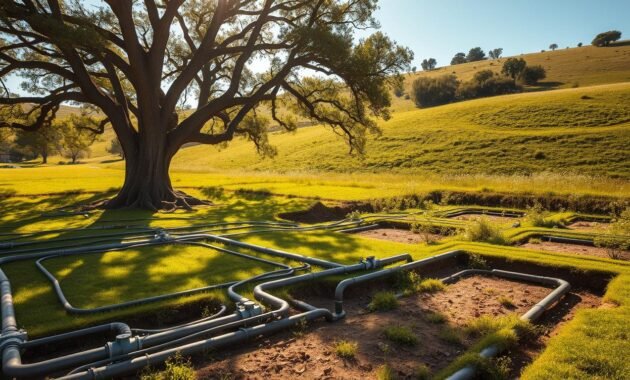Imagine finding out your septic system is failing, leading to expensive repairs and possible damage to your home. Many people don’t know their septic tank’s condition until it’s too late. Knowing how long septic systems last can save you a lot of money and prevent big problems with waste management.
As a homeowner, it’s important to know how long your septic tank will last. This knowledge is key for taking care of your system.
Whether you’re buying a new home or keeping up with your current system, this guide will tell you all you need to know. It will help you protect your investment and avoid unexpected costs.

Read also: The Pros and Cons of Septic Tanks
Understanding Septic System Basics
Septic systems are vital for managing home wastewater. They treat and dispose of household waste. Let’s explore the basics of these underground systems, important for many homes in the U.S.
Key Components of a Septic System
A typical septic system has several key parts. These parts work together to handle and treat wastewater. The main parts are:
- Main drainage pipe from the house
- Septic tank
- Distribution box
- Drainfield
How Septic Systems Process Waste
Understanding how septic systems work is key to maintenance. Wastewater from your home goes into the septic tank. Here, solid waste settles at the bottom and oils float to the top.
The middle layer, which is clearer, goes to the drainfield for final treatment.
Types of Septic Systems
There are two main types of septic systems: aerobic and anaerobic. Each has its own features:
| System Type | Oxygen Requirement | Typical Lifespan |
|---|---|---|
| Aerobic Septic System | Requires oxygen | 15-25 years |
| Anaerobic Septic System | Functions without oxygen | 20-30 years |
The lifespan of aerobic and anaerobic systems varies. It depends on maintenance, soil, and usage. Regular care is essential to extend your system’s life and avoid expensive fixes.
Average Lifespan of Different Septic Tank Materials
Understanding the septic tank lifespan starts with knowing the materials used in construction. Different materials impact how long your septic system will function effectively. I’ll break down the most common septic tank materials and their expected durability.
Concrete septic tanks are the most popular choice for homeowners. They offer a long lifespan, lasting 40 to 50 years with proper maintenance. Their durability makes them a solid long-term investment for managing household waste.
- Concrete tanks: 40-50 years lifespan
- Steel tanks: 15-20 years lifespan
- Plastic tanks: 20-30 years lifespan
Steel tanks have a shorter lifespan due to corrosion risks. Factors affecting septic system life include soil conditions, water table levels, and maintenance frequency. Homeowners should expect steel tanks to require replacement sooner compared to more robust materials.
Read also: Toilet Bowl Water Level Drops Overnight
| Tank Material | Average Lifespan | Primary Durability Factors |
|---|---|---|
| Concrete | 40-50 years | Thick construction, minimal corrosion |
| Steel | 15-20 years | High rust susceptibility |
| Plastic | 20-30 years | Lightweight, resistant to chemical breakdown |
Plastic tanks offer a middle ground, providing decent longevity with resistance to chemical deterioration. My recommendation is to consider your local soil conditions and budget when selecting a septic tank material to maximize your system’s lifespan.
How Long do Septic Systems Last
Knowing how long your septic system will last is key for homeowners. These systems are big investments that need regular care. They can last from 15 to 40 years, depending on several important factors.

Several key factors affect how long a septic system lasts. The quality of the initial setup, how well it’s maintained, and the environment around it all play a big role. These elements greatly influence how long it will work.
Typical Lifespan Range Breakdown
- Concrete septic tanks: 30-40 years
- Steel septic tanks: 15-20 years
- Fiberglass and plastic tanks: 20-30 years
Critical Factors Influencing System Duration
Many things can affect how long a septic system lasts. Here are the most important ones:
- Soil composition and drainage capabilities
- Volume of wastewater generated
- Regular professional inspections
- Household water usage patterns
- Chemical treatments and household products used
Read also: How Long do Septic Systems Last
Recognizing Signs of Aging Systems
Spotting early signs can help avoid a total system failure. Look out for slow drains, bad smells, water pooling near the drain field, or strange sounds in your plumbing. These signs mean your system might be nearing the end.
By keeping up with maintenance and getting regular checks, you can make your septic system last longer. This could save you a lot of money on replacement costs.
Drain Field Longevity and Maintenance
The drain field is key to your septic system’s success. Many focus on the septic tank, but the drain field needs care too. A well-kept drain field can last up to 50 years, making it a smart investment.
Several factors affect your drain field’s life. Proper care and maintenance can extend its life. Here are some tips to keep your drain field in top shape.
- Avoid planting trees or large shrubs near the drain field
- Prevent heavy vehicle traffic over the drain field area
- Redirect surface water and drainage away from the field
- Limit water usage during saturated ground conditions
Regular maintenance is vital for your drain field. I suggest getting professional inspections every 3-5 years. These checks can spot problems early, saving you money. Look out for signs like standing water, odd smells, or wet spots.
Your drain field’s health affects your whole septic system. By following these tips, you can avoid costly repairs. Remember, it’s cheaper to prevent problems than to fix them.
- Use water-efficient appliances
- Spread out laundry and water-intensive activities
- Avoid disposing of harmful chemicals in your system
- Maintain a consistent maintenance schedule
Proactive maintenance keeps your drain field working well for years.
Environmental Factors Affecting Septic System Lifespan
Your septic system is closely tied to its environment. Knowing what affects its lifespan can help keep it working well. The way your septic system interacts with its surroundings is key to its performance and how long it lasts.

Many environmental factors can change how your septic system works and wears out. Let’s look at the main environmental factors homeowners need to know about.
Soil Acidity and Its Impact
Soil acidity is very important for your septic system. If the soil is too acidic or alkaline, it can damage the tank and drain field. Acidic soils can also corrode metal and break down concrete, shortening your system’s life.
- Neutral soil pH (6.5-7.5) is best for septic systems
- Soils that are too acidic or alkaline can harm your system
- Testing your soil regularly can help spot pH problems
Water Table Considerations
The water table is also important for your septic system. If the water table is too high, it can make it hard for the system to work. This can lead to problems with waste processing and system failure.
Climate Effects on Septic Systems
Climate affects your septic system’s performance. Extreme temperatures, freeze-thaw cycles, and heavy rain can stress the system. In cold or rainy areas, extra steps might be needed to keep the system working.
- Cold climates need deeper system installations
- Places with lots of rain need better drainage
- Temperature changes can cause materials to expand and contract
Essential Maintenance Practices
Keeping your septic system in good shape is key. I’ll share tips to help you keep it running well and last longer.
Regular upkeep stops expensive fixes and keeps your system working right. Here are important steps for homeowners:
- Schedule professional septic system cleaning every 3-5 years
- Do annual checks on the drain field
- Watch your water use to avoid overloading the system
- Keep the drain field safe from heavy vehicles
- Don’t throw away harmful chemicals
Knowing what affects your septic system is vital. I suggest keeping track of your maintenance efforts to safeguard your investment.
| Maintenance Task | Recommended Frequency | Purpose |
|---|---|---|
| Professional Inspection | Every 3-5 years | Detect issues early |
| Tank Pumping | Every 3-5 years | Clear out solids |
| Drain Field Assessment | Annually | Check drainage |
By following these maintenance tips, you’ll avoid sudden problems and make your system last longer. It’s smarter to take care of it now than fix it later.
Signs of Septic System Failure
Spotting early signs of septic system trouble can save you from expensive fixes and protect the environment. As a homeowner, knowing these signs is key to keeping your system running smoothly and avoiding sudden failures.
Early Warning Indicators
Your septic system sends out clear signals when something’s wrong. Look out for these signs during your regular checks:
- Foul sewage odors around the property
- Standing water or wet spots near the drain field
- Slow-draining sinks, toilets, or showers
- Gurgling sounds in plumbing fixtures
- Unusual green patches or extra lush vegetation near the septic tank
When to Call Professional Help
If you see several warning signs, call for a professional septic system check right away. Experts can spot problems early and fix them before they get worse. Don’t wait until sewage spills into your home or yard.
Emergency Response Plans
Have a plan ready for septic emergencies. Keep your septic service provider’s number handy. If you think there’s a big problem, cut down on water use, avoid flushing toilets and drains, and call experts fast. This helps avoid costly repairs and damage.
Read also: Why Does My Toilet Flush Twice?
Cost Considerations and Replacement Planning
Planning for septic system replacement can be a big financial step for homeowners. A detailed septic system inspection is key to understanding costs and avoiding surprises. I’ve learned that planning ahead can save you thousands of dollars.
The cost to replace a septic system varies a lot. You might spend between $5,000 and $25,000, depending on your property. Costs are influenced by:
- Property size and terrain
- Type of septic system needed
- Local soil conditions
- Accessibility of installation site
When planning your budget, it’s wise to save money over time. Regular maintenance and timely inspections can help your system last longer. Here are some financial tips:
- Create a dedicated savings account for septic system maintenance
- Research local financing options
- Check for tax credits or municipal assistance programs
- Get multiple quotes from certified septic system professionals
Your local health department or county extension office can offer more help. They can guide you on replacement needs and financial aid for upgrades.
Conclusion
Knowing how long septic systems last is key for homeowners. This guide has explored the world of septic care and maintenance. The main point is that your system’s life depends on ongoing, proactive care.
Septic system upkeep is a continuous effort. Regular checks, smart water use, and avoiding harmful chemicals can extend its life. Most systems last 15-40 years, but your care can help it last longer.
I suggest a preventative approach. Get professional checks every few years, watch for signs of trouble, and learn about your system’s needs. Treating your septic system as a vital part of your home protects your property and the environment.
With the right knowledge and effort, your septic system can be reliable for decades. Remember, informed homeowners are the best protectors of their septic systems.


